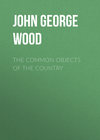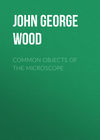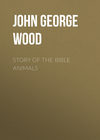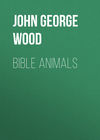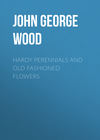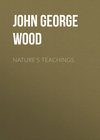Czytaj książkę: «The Common Objects of the Country», strona 9
CHAPTER IX
STAG-BEETLE—MUSK-BEETLE—TIGER-BEETLE—COCK-TAIL—VARIOUS BURYING-BEETLES—ROSE-BEETLE—GLOW-WORM—GROUND AND SUN-BEETLES, ETC.—HUMBLE-BEES, HORNETS AND THEIR ALLIES—DRAGON-FLIES—CADDIS-FLY—WATER BOATMAN—CUCKOO-SPIT—HOPPERS, EARWIG, AND LACE-FLY.
Of the remaining objects, only a very brief description can be given. Enough, however, will be said to assist the observer in identifying the object, and to serve as a guide to its locality and manners. We will first take the beetles; and as the largest is the most conspicuous, the great Stag-beetle shall have the precedence.
This insect (plate E, fig. 5) is quite unmistakable; and, from its very ferocious aspect, would deter many from touching it. But it is very lamb-like in disposition, and sometimes as playful as a lamb. Its numerous jaws can certainly pinch with much violence; but are not used for the purpose of killing other creatures, as might be supposed.
The food of the stag-beetle is simply the juices of plants, which it sweeps up with that little brush-like organ that may be seen in the very centre of the jaws. In winter it buries itself in the ground, and then, making a smooth vault, abides the winter’s cold unharmed.
Only the male beetle possesses these tremendous jaws; those of the female being hardly one-tenth of their size, but so sharp at their points that their bite is just as severe.
The insect that next comes under notice is the Musk-beetle (plate I, fig. 7), a beautiful and conspicuous insect, of a rich green colour above, and a purplish blue below. Its name of musk-beetle is derived from the fragrant scent which it emits; a scent, however, not the least like musk, but more resembling that of roses. It is so powerful that the presence of the insect may often be detected by the nostrils, though it is hidden from the eyes. It may be found chiefly on willow trees.
There is another beetle that gives out a sweet scent, much resembling that of the verbena leaf. This is the Tiger-beetle (plate D, fig. 8). With the exception of the white spots on the wing covers, the colours of this insect are much the same as those of the musk-beetle.
Its name seems hardly commensurate with its aspect; but never was a title better deserved. And, space allowing, I could here draw a terrible character; but as brevity is enforced, I can but say that this sparkling and beautiful insect seems to have the spirit of twenty tigers compressed into its little body.
All things have their opposites; and opposed to these perfume-bearing beetles are some who are just insect skunks. Chief among these is the common black Cock-tail, a creature of truly diabolical aspect. It is a carrion eater, and intensifies the carrion odour. Still, repulsive as it is, it has its beauties. Its wings are very beautiful, and the mode in which these organs are packed away under their small cases is most wonderful. It is to aid in this process that the cock-tail possesses the faculty of turning its tail over its back. Plate H, fig. 12.
Another beetle of an abominable odour is the Burying-beetle, one of which is shown on plate C, fig. 8. There are many burying-beetles, but this species is the most common.
Their name is derived from their habit of burying any piece of meat or dead animal that may be lying on the surface of the earth, not so much for the sake of themselves as for their progeny. In the buried animal their eggs are laid, and its putrefying substance affords them nourishment. The rapidity with which these and similar insects will consume even a large animal is marvellous. I have seen a large sheep stripped to the very bones in three days, nothing but bones and wool being left to mark the spot where it had lain.
Another kind of burying-beetle is seen on plate B, fig. 7; but instead of dead meat it buries the droppings of living animals, those of the cow being preferred. For this purpose it drives a perpendicular shaft into the ground, makes up a round ball of the droppings, puts an egg into the middle of the ball, rolls it into the hole, and after pushing some earth after it, sets to work at another shaft.
It is evident how beneficial the labours of these insects must be; for by their means the earth is pierced with passages for air—part is thrown out on the surface, where it becomes regenerated by the atmosphere—noxious substances are removed from the surface, where they would do harm, and placed deep in the ground, where they do good.
The popular name for this beetle is the Watchman, because in the dusk of the evening it “wheels its drowsy flight,” much as watchmen made their sleepy rounds. It belongs to the same family of insects as the sacred Scarabæus of the Egyptians.
On plate C, fig. 11, is depicted the common Rose-beetle so called because it is an insect of refined habits, and chiefly dwells in the bosom of white roses. Yet it loves earth too, and in pursuance of its mission falls from its rose to earth, and there digs a receptacle for its future progeny. But though in earth, it is not of earth; and, burrow as it may, it returns to its rose without a stain upon its burnished wings.
The curious Glow-worm, as it is called falsely, it being a beetle, and not a worm, is shown on plate J, fig. 1. Both the male and female insect give out this light, as I have often seen, though that of the female is the more powerful. The two sexes are very different in appearance, as may be seen by reference to the plate, fig. 1 being the male, and 1 a the female. The object of the light is by no means certain, nor the mode in which it is produced.
On the same plate, fig. 11, is seen the Oil-beetle, an eccentric kind of insect, which, when frightened, pours a drop of oil out of every joint, just as if it were a walking oil-barrel with self-acting taps.
One of the commonest beetles, the Ground-beetle, is seen on the same plate, fig. 10. There are very many ground-beetles, but this is one of the handsomest and most conspicuous. The embossment of its upper surface is worth a close examination, and its colouring is peculiarly rich and deep.
Hot sunny days always seem to bring out a host of insects, among which the Sun-beetles are notable examples. One of these insects is shown on plate D, fig. 6. They are beautifully brilliant as they run among the gravel-stones or over paths, their smooth surface glittering in the sun resplendently.
As an aquatic balance to the terrene Sun-beetles, the Whirligigs (plate F, fig. 4) make their appearance on the surface of the water on any light sunny day. What rule they observe in their mazy dance is more difficult to comprehend than the “Lancers” or a cotillon: but that there must be a rule is clear from the wonderful way in which they avoid striking against each other in their passage.
Every one knows the Lady Bird, with its pretty red wings and black spots. Its larva (plate B, fig. 8) is a very singular creature, and destructive withal, spearing and eating Aphides as ruthlessly as Polyphemus impaled and devoured the captured sailors. It has a curious history, but there is no room for it here.
On plate H, fig. 7, is represented one of the many Skipjack-beetles, who afford such amusement to juveniles by their sudden leaps into the air when laid on their backs. This feat is performed by means of a sudden blow of the head and thorax. Farmers, however, are not all amused by it, for it is the parent of the terrible “wire-worm,” so deadly a foe to corn and potatoes.
Some insects prefer com when placed in granaries, and these are the Weevils, whose grubs populate sea-biscuit, and run races across plates for wagers. Nuts also fall victims to the weevil represented on plate I, fig. 9, or rather to its grub, “Time out of mind the fairies’ coachmaker”.
There is a very common little green weevil shown on plate C, fig. 7, which, although ordinary enough to the unassisted eye, yet under the microscope glows with jewels and gold. It is, in truth, the British Diamond-beetle. An idea of its appearance may be obtained from plate L, fig. 6, but to give the real glory of the colouring is impossible.
One of the little insects called Death-watches is shown on plate J, fig. 8. There are many insects that go by this name, because they make a slight tapping sound with their heads, probably to call their mates; and which sound has been thought to prognosticate death rather than marriage.
The curious Tortoise-beetle is depicted on plate C, fig. 6. Its chief peculiarity is in its larval state, when it carries a kind of parasol, formed from the remains of the leaves on which it has been feeding.
Last and least of the beetles comes one as destructive as it is small, the Turnip-hopper. This little animal, no larger than a small pin’s head, does great damage to the turnip crops, and is therefore hated by farmers. It is shown, much magnified, on plate J, fig. 13.
From the beetles we proceed to the Bee tribe; and first take the common Humble-bee, several of which are shown on plate H, fig. 10, representing the “Red-hipped Humble-bee,” which mostly makes its nest among stone-heaps. Fig. 11 is the common Humble-bee, that burrows in the ground, and there builds its thimble-like cells. These cells are very irregular in shape, and are affixed to each other without any definite order. Of these two insects, the latter is harmless enough; but the former becomes very fierce if its nest is approached too closely.
A magnified view of some hairs of the Humble-bee is given on plate K, fig. 11.
There are some bees which make their nests in old walls, where they either dig for themselves a hole, or oftener take advantage of a nail-hole, and so save themselves much trouble. One of these bees is shown on plate H, fig. 2, and is chiefly remarkable for the beautifully tufted extremities of its middle pair of legs.
On plate D, fig. 7, is seen the common Hornet, one of the really terrible of our insects. It mostly makes its nest in hollow trees, and it behoves one to keep very clear of the neighbourhood. The nest is made of wood-fibre, nibbled, and made into a primitive papier-maché.
Two of the Saw-flies may be seen on plate J. Fig. 2 is the common green Saw-fly, and fig. 3 the dreaded Turnip-fly. These are called Saw-flies because they are furnished with saw-like implements, by means of which they cut grooves in certain plants, and in those grooves lay their eggs.
Mention has already been made of the little Ichneumon fly. One of these insects is shown magnified on plate J, fig. 12 a, and one of the large species is depicted on plate H, fig. 3. The threefold appendage to the tail is the ovipositor, or instrument by means of which they pierce their victims and deposit their eggs.
There are some allied insects that pierce vegetables instead of insects; and one of their works may be seen figured on plate A, where a bramble-branch has been perforated by them. The well-known oak-apples, plate B, fig. 6, are caused by a Cynips, as the little creature is called; and so is the common Bedeguar of the rose, seen on plate C, fig. 2.
The last of these insects that will be named is the beautiful Fire-tail, plate D, fig. 5, one of the most brilliant insects that our island can boast. There are many British species of this insect, but they all much resemble each other, and are insect cuckoos, laying their eggs in the nests of other insects.
From the bees, we pass to the Flies; and first take a most singular insect, shown on plate H, fig. 5. This insect is found on the blackberry blossoms, and the upper part of its body is so transparent that the leaf on which it sits can be seen through it. It is swift of wing and wary, requiring a quick eye and hand for its capture.
On the same plate, fig. 6, is shown one of the traveller’s pests, a fly that bites, or rather bores, the skin, and that with such virulence that it can even strike its poisoned dart through a cloth coat, and make its victim to lament for many an hour after.
One of the various hoverer-flies is shown on plate J, fig. 9. The larva of this insect is very remarkable, on account of its curious breathing apparatus. The larva is properly called the Rat-tailed Maggot, and is shown on the same plate, fig. 8 a. The body of the creature is found buried in the mud at the bottom of stagnant pools or cisterns, and the respiration is carried on through the telescopic tail, which is long enough to protrude through the mud, and to convey the necessary oxygen to the system through two flexible air-tubes that pass through the “tail”.
It will be remembered that in mentioning the Green Oak Moth, the Destroying Empis was also noticed. One of these flies is shown on plate J, fig. 5, with the poor Tortrix in its grasp. Plate K, fig. 1, shows its foot, and fig. 3 its head, together with its long beak.
The beak of this fly somewhat reminds one of the corresponding portion of the Gnat, which insect is not itself depicted, though on plate F, fig. 10, is shown the wonderful little egg-boat which it makes. This insect glues together its eggs in such a manner that they are formed into a true lifeboat, which cannot be upset, or sunk, or filled with water, but floats securely on the surface until the young are hatched. That object accomplished, the gnat-larvæ tumble into the water, and there undergo their transformation.
The last of the two-winged flies that will be mentioned is the common Daddy Long Legs, or Crane-fly, which seems to set such little value on its limbs. It is a very injurious insect in its larval state, feeding on roots, and doing great damage. Plate H, fig. 1, shows a very pretty species, covered with yellow rings.
Every one must have noticed the beautiful and active insects that are with great truth called Dragon-flies. Their habits and peculiarities would demand a volume; and here they can but be mentioned. Plate F, fig. 6, shows the common Flat Dragon-fly, that may be seen chasing and following flies of all sizes, and even butterflies. Fig. 8 is the elegant Demoiselle, the male of which is shown here, with its dark purple spots on the wings and dark blue body. The female is of a uniform green. Its larva is shown at fig. 8 a, where the singular leafy gills may be seen at the end of its tail. Fig. 7 shows another very common Dragon-fly, very thin and ringed with blue circlets.
On the same plate, fig. 12, may be seen several varieties of the objects known to fishermen as “Caddis” cases. These are residences built by the larva of the common Caddis, or Stone-fly, which is represented on the same plate, fig. 9.
Still keeping to plate F, and referring to fig. 1, is seen the horrid-looking Water-scorpion, a creature which, though it does not sting, has much of the scorpion nature, and so bites. Fig. 1 a shows the same insect as it appears when flying.
At fig. 3 is seen the Water Boatman, so called because it lies on its back, which is ridged like the keel of a boat, and then rows itself about by means of its middle pair of legs, which closely resemble oars.
Fig. 5 shows a very curious object which is common enough on the margin of pools, and runs on the surface of the water as if it were dry land. When alarmed, it shuts up all its legs, and looks just like a piece of dry grass or thin stick.
Another insect much resembling it, is the common Gerris, seen on plate I, fig. 6. It may be seen on every pond or still water, running over its surface, and is furnished with wings wherewith it can fly to great distances. I have found specimens on the tops of hills, far from any water, and hiding under stones out of the sun’s heat. Fig. 1 shows the common May-fly.
All gardeners have been annoyed with the curious production called the Cuckoo-spit. This proceeds from the larva of one of the hoppers, and on removing the frothy substance, the little soft, greenish insect may be found within. The perfect insect is shown on plate C, fig. 1 a, and the exudation itself at fig. 1.
There is another hopper seen on plate B, fig. 2, called from its colour the Scarlet Hopper. It is common enough on ferns, and may be found chiefly in the open spots of forests where ferns abound.
On plate J, fig. 7 a, is the common Green Grasshopper, as it appears when standing; and on fig. 7, the same insect as it appears when using its wings.
The common Earwig, plate I, fig. 8, is introduced for the purpose of showing the very beautiful wing which this insect possesses, and which is seen expanded at fig. 8 a.
The very lovely, though ill-odoured, Lace-wing Fly is shown on plate J, fig. 4, and its very remarkable eggs at 4 a. Each egg is placed at the end of a footstalk, whereby it is kept out of the reach of certain predacious insects.
Various shells are drawn on one or two of the plates, but there is not space for any description. Their names may be found on the Index to Plates. Plate G contains certain fungi and mosses. Fig. 1 is that peculiar plant which reindeer scrape from under the snow in the winter time. Fig. 2 was once dreaded by rustics as “Witch’s butter”. Fig. 6 shows the curious Earth-star, chiefly remarkable for its resemblance to the marine Star-fish.
INDEX
A.
Adela, 153.
Admiral Butterfly, 156.
Armadillo, 87.
B.
Bat, 4.
Bedeguar, 172.
Bird-nest moss, 176.
Blind-worm, 45.
Blue Butterfly, 160.
Brimstone Butterfly, 163.
Brimstone Moth, 147.
Buff-tip Moth, 132.
Burnet Moth, 113.
Burying Beetle, 116.
C.
Cabbage Butterfly, 161.
Caddis, 174.
Clear-wing Moth, 149.
Cock-tail Beetle, 166.
Crane-fly, 173.
Cray-fish, 81.
Cuckoo-spit, 175.
Cup Moss, 176.
Cynips, 172.
D.
Death-watch, 169.
Drinker Moth, 123.
Dragon-flies, 174.
E.
Earwig, 175.
Eft, 65.
Elephant Hawk Moth, 130.
Emperor Moth, 126.
Empis, 140.
F.
Field Mouse, 17.
Fire-tail, 172.
Frog, 55.
G.
Galls, 171.
Gerris, 175.
Glow-worm, 167.
Gnat Eggs, 173.
Gold-tailed Moth, 133.
Grasshopper, 175.
Ground Beetle, 168.
H.
Harvest Mouse, 20.
Hopper, scarlet, 175.
–– Cuckoo, 175.
Hornet, 171.
Hoverer Fly, 172.
Humble-bee, 170.
Hydrometra, 174.
I.
Ichneumon, Microgaster, 162.
L.
Lace-wing Fly, 176.
Lackey Moth, 143.
Lady-bird, 169.
Lampern, 78.
Lappet Moth, 145.
Leaf Miners, 141.
Lizard, 43.
Long-horn Moths, 152.
M.
Magpie Moth, 148.
Mason Bee, 124.
May-fly, 175.
Mole, 34.
Mouse, Field, 17.
–– Harvest, 20.
–– Shrew, 26.
Musk Beetle, 165.
N.
Newt, 65.
O.
Oak-apples, 172.
Oak Egger-moth, 115.
Oak Moth, 137.
Oil Beetle, 168.
Orange-tip, 161.
P.
Peacock Butterfly, 160.
Pill Millepede, 86.
Plume Moths, 150.
Privet Hawk-moth, 130.
Puss Moth, 110.
R.
Rat, Water, 21.
Rat-tailed Maggot, 172.
Reindeer Moss, 176.
Rose Beetle, 167.
S.
Shrew, 26.
–– Water, 32.
Shrimp, Fresh-water, 85.
Skipjack Beetle, 169.
Snake, 49.
Stag Beetle, 164.
Stickleback, 74.
Sting-fly, 172.
Stone-fly, 174.
Sun Beetle, 168.
T.
Tiger Beetle, 165.
–– Moth, 94.
Toad, 59.
Tortoise Beetle, 170.
Turnip Fly, 171.
–– Hopper, 170.
V.
Vapourer Moth, 136.
Viper, 48.
Volucella, 171.
W.
Watchman Beetle, 167.
Water Scorpion, 174.
–– Boatman, 174.
Weasel, 39.
Weevils, 169.
Whirligig Beetle, 168.
Witch Butter, 176.
Woodlouse, 86.
INDEX TO PLATES
A. (Front)
1. Tubercled Gall on Bramble-stem.
2. Track of Leaf-Miner on Bramble-leaf.
3. Gnat-Clearwing Moth.
4. Buff-tip Moth.
–a. Caterpillar of do.
5. Privet Moth.
–a. Caterpillar of do.
6. Snail (Helix nemoralis).
7. Do. (Helix nemoralis) var.
8. Do. (Helix cantiana).
9. Do. (Helix ericetorum).
10. Do. (Helix lapicida).
11. Shell (Cyclostoma).
12. Do. (Zonites).
13. Do. (Helix caperata).
14. Do. (Pupa).
15. Do. (Clausilia).
B.
1. Green Oak Moth (Tortrix).
2. Scarlet Hopper (Cercopis).
3. Burnet Moth.
–a. Cocoon of do.
4. Puss Moth.
–a. Caterpillar of do.
5. Tiger-Moth (Arctia).
–a. Caterpillar of do.
–b. Cocoon of do.
6. Oak-galls.
7. Watchman Beetle (Geotrupes).
8. Lady-bird (Coccinella).
–a. Larva of do.
C.
1. Cuckoo-spit.
–a. Cuckoo Hopper (Tettigonia).
2. Bedeguar of Rose.
3. Brimstone Moth.
–a. Caterpillar of do.
4. Emperor Moth.
–a. Caterpillar of do.
–b. Cocoon of do.
5. Elephant Hawk-Moth.
–a. Caterpillar of do.
6. Tortoise Beetle (Cassida).
7. Green Weevil.
8. Burying-Beetle (Necrophorus).
9. Twenty-Plume Moth.
10. Green Adela.
11. Rose-Beetle.
D.
1. Blue Butterfly (Alexis).
–a. Do. Wings closed.
–b. Caterpillar of do.
–c. Pupa of do.
2. Orange-tip Butterfly.
3. Vapourer Moth, Male.
–a. Do Female.
4. Red Admiral.
–a. Caterpillar of do.
–b. Pupa of do.
5. Fire-tail (Chrysis).
6. Sun Beetle.
7. Hornet.
8. Tiger Beetle.
–a. Do Flying.
E.
1. Drinker Moth, Male.
–a. Do. Female.
–b. Do. Caterpillar.
–c. Do. Cocoon.
–d. Do. Chrysalis.
–e. Do. Eggs.
2. Humble-bee Fly (Bombyllus).
3. Magpie Moth.
–a. Do. Chrysalis.
–b. Do. Caterpillar.
4 Gold-tailed Moth (Porthesia).
–a. Do. Caterpillar.
5. Stag-Beetle.
F.
1. Water Scorpion.
–a. Do. Flying.
2. Amber Shell (Succinea).
3. Water Boatman.
4. Whirligig Beetle.
5. Hydrometra.
6. Dragon-Fly (Libellula).
7. Do. (Agrion).
8. Do. Demoiselle (Calepteryus).
–a. Do. Larva.
9. Stone-Fly (Phryganea).
10. Eggs of Gnat.
11. Caddis-cases, composed—
a. Of flat stones.
b. Of bark.
c. Of sand.
d. Of grass.
e. Of grass-stems.
f. Of shells.
12. Water shells.
g. Planorbis.
h. Ancylus.
i. Lymnæus.
k. Paludina.
G.
1. Reindeer Moss (Cladonia).
2. Witch-butter (Tremella).
3. Polytrichum.
4. Bird-nest Moss (Nidularia).
5. Xylaria.
6. Earth-star (Geastrum).
–a. Do. closed.
7. Arscyria.
8. Cup-moss (Cenomyce).
9. Scarlet Cup-moss (Peziza).
10. Marchantia.
H.
1. Crane-fly.
2. Mason Bee (Megachile).
3. Ichneumon (Pimpla).
4. Adela Long-horn.
5. Volucella.
6. Sting-fly (Chrysops).
7. Skipjack Beetle (Elater).
8. Peacock Butterfly.
–a. Do. wings closed.
–b. Do. Caterpillar.
9. White-Plume Moth.
10. Red-tailed Humble-Bee.
11. Common do.
12. Cock-tail Beetle (Goërius).
I.
1. May-fly (Ephemera).
2. Scorpion-fly.
3. Brimstone Butterfly.
4. Cabbage White Butterfly.
–a. Do. Caterpillar.
5. Oak Egger-Moth, female.
–a. Do. Cocoon.
6. Gerris.
7. Musk Beetle.
8. Earwig.
–a. Do. flying.
9. Nut Weevil.
J.
1a. Glow-worm, male.
–b. Do. female.
2. Green Saw-fly (Tenthredo).
3. Turnip-fly.
4. Lace-wing Fly.
–a. Eggs of do. on lilac branch.
5. Empis.
–a. Do. killing Oak-moth.
6. Ichneumon (Microgaster) and cocoons.
7. Grasshopper, flying.
–a. Do. walking.
8. Death-watch (Anobium).
9. Hoverer-fly.
–a. Rat-tailed Maggot.
10. Ground Beetle (Carabus).
11. Oil Beetle.
12. Cocoon of Microgaster, magnified.
–a. Microgaster, magnified.
13. Turnip-hopper (Haltica), magnified.
–a. Do. natural size.
14. Cyclops, magnified, showing egg-sacs.
15. Scarlet Spider (Trombidium), magnified.
–a. Do. natural size.
K. Microscopical.
1. Foot of Empis.
2. Pollen—a. Sunflower.
b. Passion Flower.
c. Lily.
3. Head of Empis.
4. Foot of Male Water-Beetle (Dyticus).
5. Trunk of Blue-bottle Fly.
6. Foot of Frog, showing circulation.
7. Petal of Geranium, showing stomata.
8. Battledore Scales of Blue Butterfly.
9. Scale of Fritillary Butterfly.
10. Eye of Butterfly.
11. Hairs of Humble-Bee.
L. Microscopical.
1 and 3. Scales of various Butterflies.
2. Eye of Hemerobius.
4. Wing of Peacock Butterfly.
5. Poppy seeds.
6. Wing-case of Green Weevil.
7. Egg of Red Underwing Moth.
8. – of Small White Butterfly.
9. – of Tortoiseshell Butterfly.
10. – of Lathonia Butterfly.
